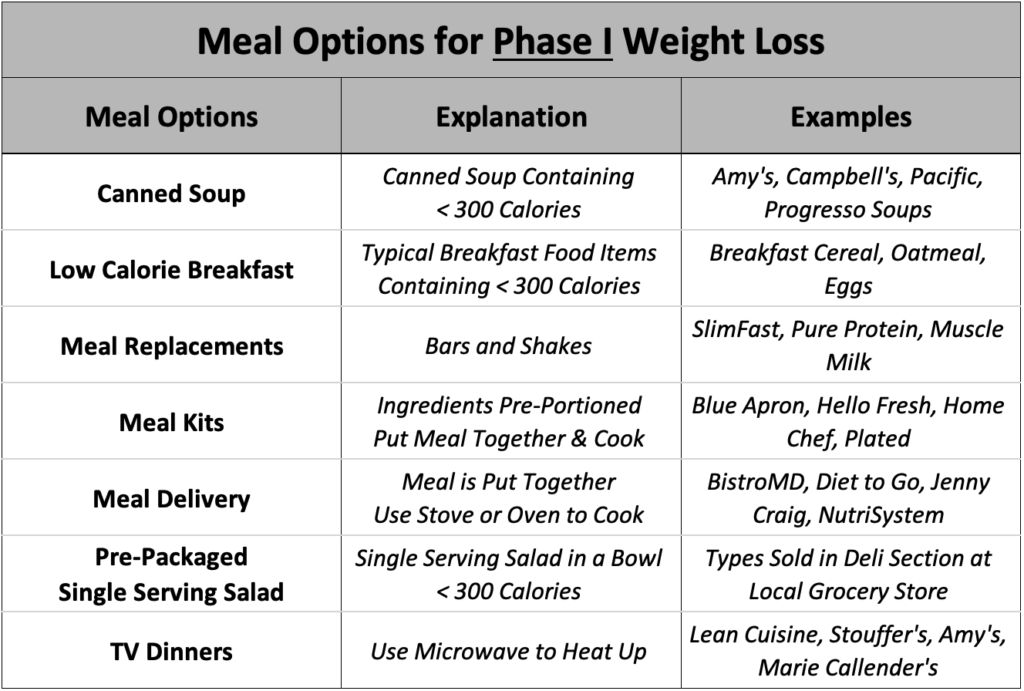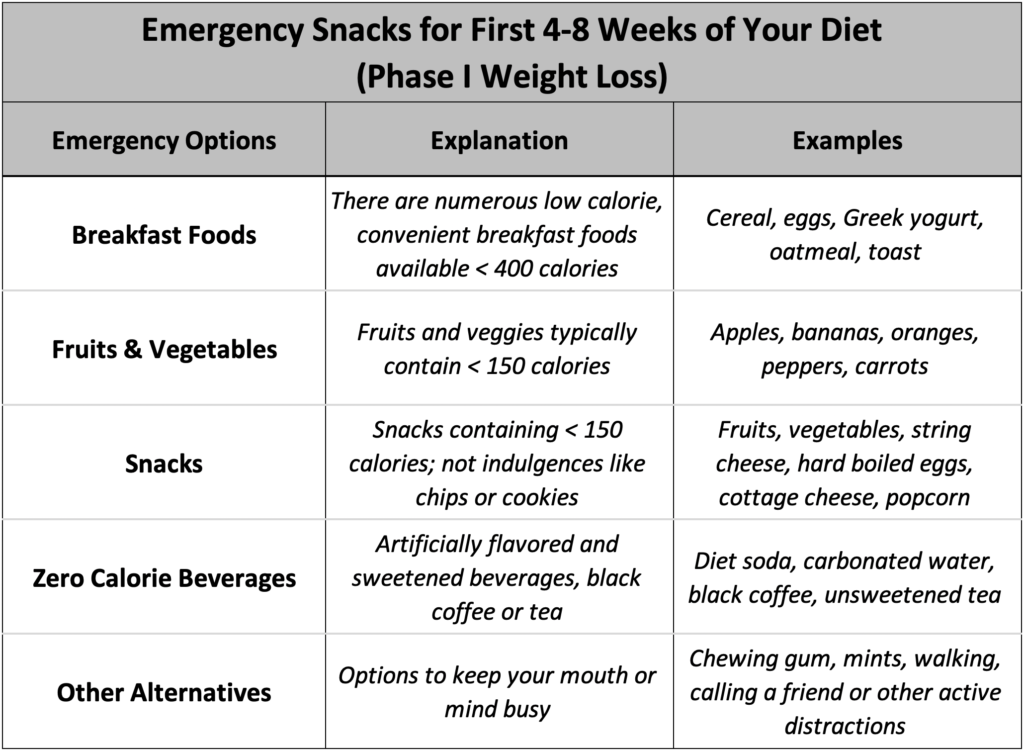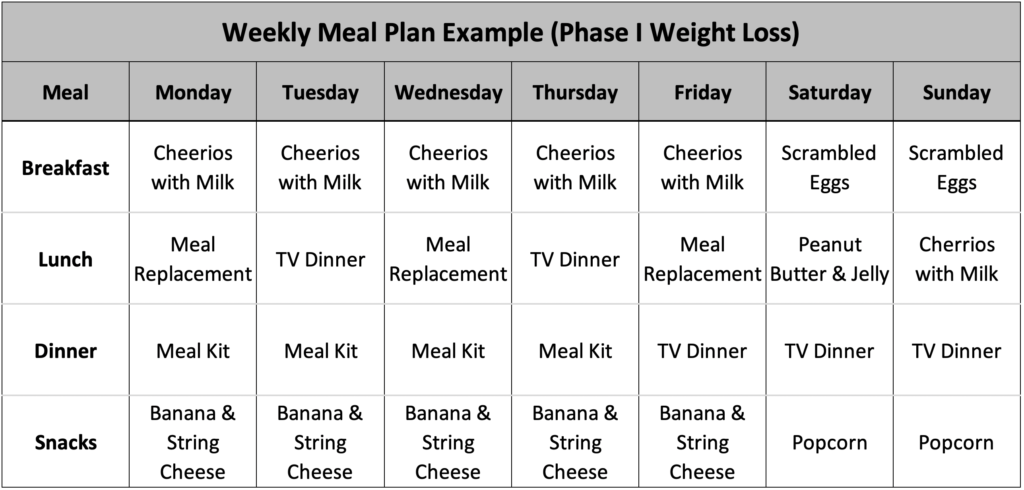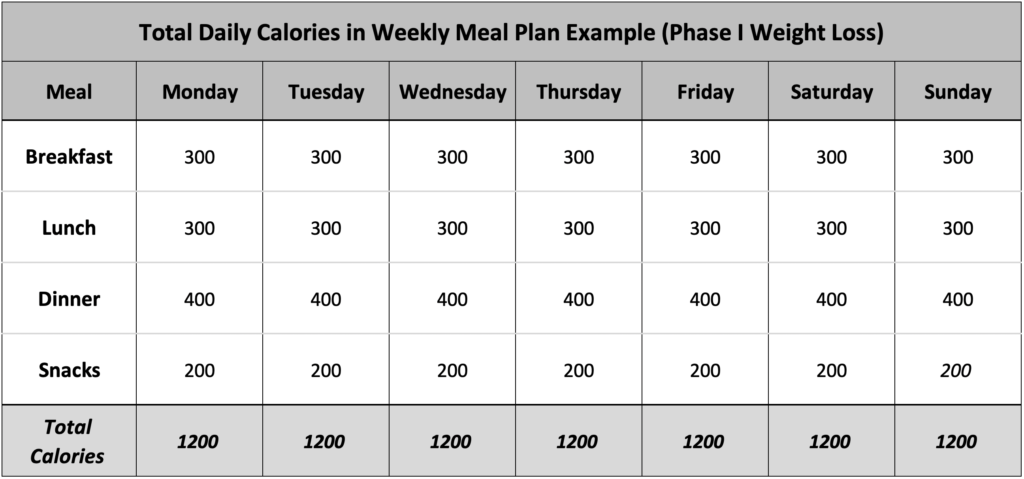The first two to three months of your diet are so important that you can’t afford to mess around. Sixty to seventy-five percent of the weight that you are going to lose on your diet is going to come in these first two to three months. As you saw in our last section (10), The First 3 Months of Your Diet Will Determine What You Weigh Years from Now, the people who lose the most amount of weight in these first 2-3 months will also maintain the greatest weight loss over the coming years.
During the first 2-3 months you are trying to consume between 800 and 1200 calories/day. 800 to 1200 calories/day is barely anything and adds up very, very quickly. You are likely used to consuming 2, 3, 4 or even 5 times that number of calories in a day. To get down to this calorie level, you can’t make a few small changes to your diet, you need to blow it up and start over!
In our earlier section (07), There are Three (and Only Three) Ways to Incur a Calorie Deficit, we talked about how you can only cut calories through portion size, food frequency or energy density. There are WAY TOO MANY food decisions that you would need to make in your current diet to be able to reduce your calorie intake down to 800 – 1200 calories. You just do not have enough calories to work with to afford making any mistakes. If you are given too much wiggle room in your diet you’re going to consume too many calories, intentionally or unintentionally. It’s going to happen. This is why I recommend using meal replacements, meal kits or meal delivery services to be able to control your
- Portion Size
- Food Frequency
- Energy Density
Now, you should be asking, what exactly are meal replacements, kits, and delivery? Isn’t eating out (delivery) the worst thing you can do on a diet?
Meal replacements are bars and shakes that literally take the place of a normal meal (you eat them instead of eating “real food”). Meal kits contain all of the ingredients you need to make a meal already prepared and portioned out for you, all you have to do is put it together and cook it. Meal delivery options are meals that are already prepared for you, there’s no mixing or putting ingredients together. That’s already done. All you have to do is pop it in the oven or warm it up or on the stove. TV Dinners are the old school microwavable dinners that you typically purchase at your supermarket (Table 11.1).

The reason why I recommend shooting for 4-8 weeks and not 12 or more is because this plan is difficult to follow. It is a real sacrifice eating such a restrictive diet for such a long period of time but the research literature on weight loss shows that this is the most effective approach. And the better you execute this short-term sacrifice, the better your long-term results are going to be. Depending on how much weight you have to lose and how well you execute phase I of your weight loss journey you may never have to do this again.
I would recommend trying a few different meal replacements, kits, delivery, and tv dinners before you start your weight loss journey to see what you like, what tastes good, what keeps you full, and the type of meal option that you like to eat at breakfast, lunch, and dinner. It’s also not a bad idea to supplement these meal options with built in emergency snacks (Table 11.2).

I hesitate to say that you should incorporate all of these because it is too easy to eat two cheese sticks, a banana, and piece of toast and before you know it you’ve consumed an additional 500 calories. With that being said, if you are starving between meals, then maybe you want to try some of these low or no calorie options to supplement your diet.
Here is what a weekly meal plan could look like for your first four weeks of weight loss (Table 11.3).

Breakfast would consist of a relatively non-sugary cereal, lunch is a meal replacement bar or shake on Monday, Wednesday, and Friday. TV Dinners are for lunch on Tuesdays and Thursdays and Meal Kits are for dinner Monday – Thursday. I wouldn’t recommend cooking every night but if you cooked a double batch on Monday and Wednesday and ate leftovers Tuesday and Thursday, that would get you through the week. Weekends are typically a little less structured than weekdays so you could try a few different options and break up your weekday monotony.
In the plan listed above I have included a banana and a string cheese for your snacks. You can eat these at any time of the day and obviously they don’t have to be those two specific snacks. Regardless of what type of snack you are choosing, be very careful to read the label. For example, there are some very high calorie, sugary yogurts. Make sure they don’t contain too much carbohydrate. Also, eating your cheerios with skim milk instead of whole or 2% will save you 50 -100 calories. With that being said though, everything is fair game. If you feel like 2% if more satisfying, then use 2% or eat a slightly smaller bowl to make up for the difference. One food choice will not make or break your diet but each choice does add up.
Remember, your total daily calorie intake should be between 800 – 1200 calories. You can mix and match your breakfast items, meal kits, delivery, replacements, and snacks any which way you choose. That’s totally up to you, your schedule, and your preferences. But it would seem that spreading your calories throughout the day might be the best way to squeeze the most out of them (hunger wise). Below (Table 11.4) I have included what the calorie breakdown would look like if you were to follow the meal plan example I posted above (Table 11.3).

Before you start your Phase I weight loss, there are a few things you need to do.
- Purchase a scale if you don’t already own one
- Weigh yourself to establish a baseline weight
- Clean out your pantry to eliminate any temptations you might have
- Try a few meal replacement, kit, and delivery options before “officially” choosing one to go with
- Pick a start date on your calendar
- Create a meal plan for that week and make sure you have everything you need
- Create the following week’s meal plan toward the end of week one
- Weigh yourself at least weekly to track your progress
There is a lot more that you can/should be doing but this isn’t meant to be an exhaustive list, rather a few important considerations before starting.
Following such a restrictive diet isn’t going to be easy but it is a necessary evil. If you can make the sacrifice for 4-8 weeks, it should pay off in the long run. In our next section (12), Home Cooked Meals are the Key to Your Long-Term Success after Meal Replacements, I would like to share with you why cooking meals at home is so important to your weight loss success as well as a few tips for making home cooking a little less inconvenient.